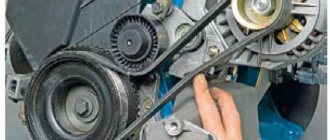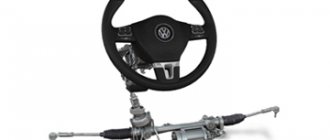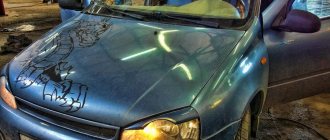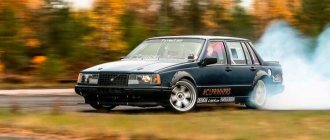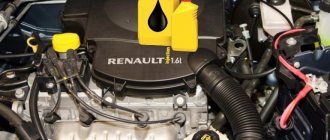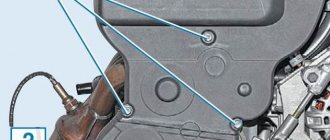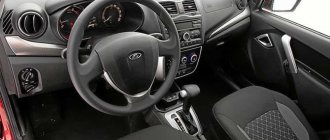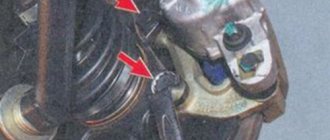Steering mechanism Lada Kalina
The development of the Lada Kalina design began at AvtoVAZ in the 90s.
A line of cars was conceived, including the 1119 sedan, 1118 hatchback and minivan. The last model was never implemented; instead, a station wagon 1117 was developed. In 1999, a hatchback prototype was demonstrated, and in 2000, a future sedan model was demonstrated. The first generation of cars lasted on the market for about ten years; since 2014, AvtoVAZ has been producing an updated series, including the Kalina Cross all-terrain vehicle, which is distinguished by greater comfort, a new engine and design. On all Lada Kalina models, a steering mechanism was installed only with a rack and pinion drive, depending on the configuration, equipped with or without electric power steering (EPS). Hydraulic power steering (power steering) was installed only on the Lada Priora and the Niva SUV.
Characteristics of the steering mechanism of different modifications of Kalina
The steering mechanism (RM) is one of the most important elements of a car and is designed to change the trajectory of its movement. Control is carried out by turning the steering wheel, and the greater the angle of rotation, the more the car turns. Among the variety of PMs, rack and pinion mechanisms are most widespread due to their simplicity of design, low weight and size, high reliability and low cost.
All models and modifications of the Lada Kalina car have a standard safety rack and pinion mechanism, which is equipped with an electric amplifier.
The steering column can change its angle depending on the driver's height, ensuring comfortable driving. Currently, there are three manufacturers supplying components for electric power steering: Makhachkala, Aviaelectronics in Kaluga and Korea. All electric boosters are available for free sale and you can choose any one, but experienced drivers prefer the Korean device.
Design features
The structure of the Lada Kalina steering unit includes:
- electric amplifier;
- steering column, adjustable for reach and tilt;
- electric power steering rack with gear ratio change mechanism;
- rods with tips, as well as rotary levers.
In the mechanism housing there is a unit with mechanical gearing, where the main operating element is a helical gear, the pitch of the teeth of which varies depending on the length of the rack.
The figure shows the design of the Lada Kalina rack and pinion unit.
The pressure in the rack-and-pinion pair is carried out by means of a spring, and the plastic liner present is designed to reduce the friction force. The compression level of the spring element is adjusted using a nut. The factory gap between the steering shaft and the rack is 0.1 mm in the LADA Kalina model.
If a knock appears inside the unit, it can be eliminated by adjusting the gap with your own hands. The steering shaft is centered using two bearings, one of which is located in the column bracket, and the second is located inside the electric power steering housing. The bracket is connected both to the pedal mounting unit, or rather to its front part, and to the body. Structurally, the bracket together with the pipe forms a hinged connection from a pair of plates. This unit provides a change in the position of the steering wheel, where the width of the range of movement is limited by slots in the designated plates.
The specific position of the pipe is fixed by a lever, which is connected to a special bushing that performs an adjustment mission. It is screwed onto a coupling bolt located just in the slots of the plates. When the lever is turned, the sleeve rotates synchronously. At this moment, the fixation of the plate weakens, and the steering wheel begins to change its position. Springs located in the middle of the bracket and plates, when the fastening is loosened, pull the pipe in the upward direction.
Let us repeat, the steering unit of the Lada Kalina has two rods and rotary levers. The rod design includes two tips, one of which is external, and the second is internal. The process of adjusting the length of the rod is carried out by rotating the threaded bushing present here. Having completed the adjustment manipulation, the position of the tips should be fixed with specially designed bolts. The outer rod end is connected to the swing arm bracket via a ball joint.
The power steering mechanism, operating on an electric drive, changes its degree of gain depending on the driving speed. When the car is stopped, the amplifier produces maximum torque, and the steering wheel turns very easily. As the speed increases, the force on the steering wheel of the Lada Kalina increases, which is facilitated by a decrease in the torque generated by this unit. The mechanism is based on an electric motor, which transmits rotation through a gearbox “hidden” under the column casing. The amplifier is controlled using an electronic unit, which is supplied with impulses from speed sensors, recognizes the amount of force when rotating the steering column shaft, and also reads the number of revolutions of the engine shaft. The instrument panel has a special indicator that allows you to monitor the operation of the amplifier.
Operating principle and design of rack and pinion steering mechanism
When the steering wheel rotates, torque is transmitted through the column shaft through a helical gear to the rack, which is connected to rods that change the angle of rotation of the wheel hub. The working pair in the rack and pinion mechanism is the helical gear located on the column shaft and the PM rack.
Kalina's steering rack is placed in an aluminum housing (case), which includes a helical gear connected to the column shaft. The helical drive gear meshes with a rack and is supported by two bearings and a bushing on the crankcase. The rack also has an oblique tooth with a variable pitch, with a smaller pitch on the peripheral part. As a result, the driving behavior becomes more natural and comfortable, and the steering wheel angles are reduced. In a car with a variable ratio rack, the steering range of rotation is 720°. In this case, the driver, turning the wheel one revolution, reaches the right or left stop. During linear motion, the gear shaft is in the zone of straight teeth. When cornering or maneuvering, the steering responds more dynamically. In the area of the rack, which has oblique teeth, the gear ratio decreases rapidly as the steering angle increases.
For fans of fast driving, a Kalina Sport steering rack can be installed, which has a gear ratio of 3.1, unlike other models, in which this figure is 4.02. This shortened version allows you to feel the car better, but increases the risk when driving at high speeds.
Video
This video shows how to repair the steering mechanism on Kalina.
Knock in Kalina steering rack. How to remove.
Installation of Kalina steering rack.
Repair of the steering column gearbox and the RR itself on Priora, Kalina, Grant.
How to install a steering rack from Kalina 2 to Kalina 1.
Steering rack for Lada Kalina Sport with a gear ratio of 3.1 instead of 4.02.
Do-it-yourself repair of the steering rack, but not Kalina, but Daevoo Sens / Daewoo Sens.
0
Author of the publication
offline for 3 weeks
Malfunctions of RM Kalina and ways to eliminate them
Even the most reliable mechanisms wear out, especially if they are not protected from dust, dirt, water and aggressive environments. Although the steering rack of the Lada Kalina is located under the hood of the car and is protected from below by a pallet, during operation, especially in off-road conditions, it is exposed to all of the listed factors. The main malfunctions of the PM can be grouped into three groups:
- large free play of the steering wheel;
- knocking, noise and creaking in the mechanism;
- tight steering wheel.
Increased play, squeaks and knocking of the Kalina PM can be caused by:
- loosening the tie rod nuts,
- wear of their tips and silent blocks,
- loosening the PM fastening nuts,
- large gap between the rack and the adjusting nut.
These faults are easy to fix: you need to tighten the nuts and pin them where necessary, and replace the silent blocks with new ones.
Difficulty turning the Lada Kalina steering wheel can be caused by more serious reasons:
- wear of the bearings of the upper support of the steering column upper universal joint,
- damage to the rack support bushing,
- failure of the telescopic strut of the front suspension,
- faulty electric power steering or low tire pressure.
If the last reason can be dealt with quite easily by inflating the wheels to the level specified in the car’s operating manual, then to eliminate the rest you will need to replace parts and assemblies with new ones.
Many Lada Kalina owners are interested in whether it is possible to replace the standard rack with a mechanism of a different design. It's possible, but not necessary. The manufacturer does not structurally provide for the replacement of the rack and pinion steering mechanism with other types. Worm or screw PMs simply won't do. To facilitate steering wheel rotation, an electric power steering is installed on all Kalina models.
Debugg
The main factor in the occurrence of knocking in the EUR is the presence of play that appears during the use of the Lada Kalina. So, if there is a drumming noise, the bearings are probably loose. Often, the smallest of the 3 electric drive rotor bearings, located at the top of the conical component of the power steering housing, rattles. You should literally tighten the adjusting nut, but do not overdo it. Otherwise, the bearing will fail.
Some modifications of the EUR do not provide an adjusting nut. If the amplifier is disassembled, then adjusting washers can be seen between the gear and bearing. In this situation, it will be possible to reduce the backlash by installing auxiliary washers, selecting them experimentally. Please note: the thicker the gasket, the harder the steering wheel will become. In turn, too small a thickness of the washer will provoke a knocking sound from the electric power steering.
During such modification, the EUR will need to be removed and disassembled. The most difficult thing will be to divide the EUR into 2 halves. During reassembly, be sure to apply lubricant. In addition, you should act carefully so that during the assembly process you do not break off a weak thread.
If you hear a metallic sound when you turn the steering wheel all the way in either direction, you probably hit the end of the rack. No need to worry here. Meanwhile, in some situations it will be necessary to repair the EUR and replace worn parts. A radical method of getting rid of knocking is to get rid of the EUR altogether or replace it with a gearless one.
A knock when turning the steering wheel is not always caused by the electric power steering; sometimes noise appears due to the steering rack or column.
Tightening and adjusting the rack
During the operation of the vehicle, natural wear and tear occurs on the contacting parts, including the PM rack. The presence of such wear can be easily recognized by the characteristic knocking sound of the mechanism at low speeds on uneven roads. This sound also produces a vibration that you can feel through the steering wheel. The initial stage of wear is easy to eliminate; this requires adjustment of the Kalina steering rack, which is easy to do with your own hands.
First of all, you need to loosen the three clamps on the air duct pipe:
- on the mass air flow sensor,
- on the crankcase ventilation pipe,
- on the throttle assembly.
After removing the air duct pipe, a large enough space opens up so that you can stick your hand in with a special wrench to adjust the rack and tighten the nut on the end of the PM crankcase. By turning the adjusting nut a quarter turn clockwise, you can begin installing the disassembled pipe and testing the machine. If the knocking noise has disappeared and when the car is moving, the steering wheel automatically returns from its extreme position, then the adjustment was made correctly. If the steering wheel does not return, you have over-tightened the rack. You will have to perform all the procedures again and loosen it somewhat, and then check again. If the knocking noise does not disappear when the nut is fully screwed in, then replacing the steering rack on Kalina is inevitable.
Causes of knocking noises and dismantling the rack
The most common cause of knocking is excessive wear on the ball joint of the tip. This malfunction requires an immediate replacement of the specified element, since further movement may become unsafe, and everything can be done with your own hands using a special repair kit.
The presence of malfunctions in the mechanism considered here, in addition to knocking, can also result in feedback in the steering wheel, which is noticeable to the driver.
It is also possible for the LADA Kalina steering wheel to “bite” in extreme positions. Here, adjustment and repair of the steering rack are extremely necessary. If after these measures the expected result is not observed, then the only way is to replace the steering rack assembly. A fairly common cause of knocking is a banal loosening of the bolt fasteners on the crankcase of the unit.
The design solutions present in the rack do not allow adjustment and tightening of the spring without dismantling the mechanism. But replacement is possible with your own hands using a repair kit.
To remove the rack you will need to perform the following sequence of actions.
- We lift the front of the LADA Kalina car using available specialized tools.
- We operate in the interior of the LADA Kalina and unscrew the bolt that holds the steering column in the adjusted position.
- Remove both front wheels.
- Unscrew the nuts of the swing arms and remove the ends.
- Under the hood you will need to remove the battery paired with the platform.
- We take out the heat reflector.
- We unscrew the fasteners that hold the electric power steering rack to the body. Now we calmly remove the knot out.
Changing the EUR on Lada Kalina
The electric power steering is mounted on the steering column and is removed along with it. First you need to turn off the power to the car by removing the battery terminal and position the front wheels straight. To dismantle the Kalina steering wheel, remove the lower cross member of the instrument panel, disconnect the wires from the EUR control unit and the switches located on the column, and then lower the steering wheel to the floor.
Now it is convenient to unscrew the nut of the bolt securing the lower universal joint to the steering gear shaft. Then we open the joint connection, use a flat screwdriver to remove the intermediate cardan from the pinion shaft of the RM Kalina and dismantle the column along with the electric power steering. After replacing the EUR with a new one, installation is carried out in the reverse order to that described above.
For safety reasons, replacement of various components and mechanisms should be carried out only with those approved by the Kalina manufacturer. If the vehicle requires repair, it must be carried out immediately, otherwise the risk of creating dangerous situations on the road increases. If damage is detected or there are irreparable faults, the mechanism must be replaced.
How to adjust the spring and tune the amplifier?
Rail
The spring requires adjustment due to its natural tendency to stretch over time. The tightening should be done after disconnecting the steering unit shaft. The action does not imply the need to remove the entire mechanism from the car.
Repairing the steering rack involves correctly setting the amount of gap observed between the shaft gear and the rack itself.
- To do this, the rack assembly will need to be set to the central position and secured against spontaneous displacement.
- Remove the rubber plug.
- Place the indicator probe inside the opened hole and make sure it comes into contact with the stop (close).
- We rotate the gear shaft, with the help of which the stop is pushed out. We measure the length of its movement with an indicator, which should be within 0.05 mm.
If we observe an excess of the measured value beyond the designated limit, we resort to eliminating it by rotating the adjusting nut. After completing the procedure, we check whether the electric power steering rack rotates easily in the crankcase by rotating the steering wheel all the way in both directions.
Note that the adjusting nut should be rotated with a special wrench. Do not try to tighten this nut with great force, as this may cause difficulty in turning the steering wheel, especially in extreme positions. It is advisable to make adjustments in stages. First, turn the key 20-25 degrees and check the assembly for absence of knocking during the rack movement. If the knocking does not disappear, then we add the angle of rotation by about 10-15 degrees and again resort to control. It happens that a lift does not lead to the expected result. This hints at repairs, and perhaps only the steering rack will need to be replaced.
Installing a 3.1 turn steering rack on a Lada Kalina (sport), cardan and amplifier.
I installed the rail a long time ago, but there was no time to write.
It all started with the fact that I took out a rack from a Kalina Sport, found the necessary lubricant, bought an intermediate steering shaft SS-20 and a disc spring.
new rack and intermediate shaft SS-20
Everything you need to prepare the rail for installation is written here
A front panel amplifier was also purchased from a technomaster. It is needed so that the rack “walks” less. The effect can be appreciated when turning at high speed.
There is nothing complicated in the replacement itself, the steering cardan is unscrewed from the interior, on one side it connects the rack and on the other the EUR. True, I had to struggle with it to tighten the last bolt, which is closer to the EUR, it’s very inconvenient to climb, I struggled for several hours) I didn’t take a photo, and nothing will be visible there.
Factory intermediate shaft
To replace the rack, first unscrew the cardan from the interior, then remove the steering rods with a puller:
press-out puller
Then we unscrew 4 nuts (2 on both sides), for convenience you need to remove the battery, remove the rack from the studs and take it out through the left (in the direction of travel) opening for the steering rods.
view from under the hood
view from the left steering rod opening
old and new slats on the fret viburnum. New – Lada Kalina Sport
The amplifier is installed very simply; the ears from the amplifier are placed in place of the standard rail mounting ears, then the pipe is screwed to them. It’s just better to do this under the hood, otherwise the rail may simply not fit through.
new rack with amplifier
Then we put everything together in reverse order; we definitely need to do a wheel alignment.
new rack with amplifier view from under the hood
new rack with amplifier view from under the hood
steering rod with old strut
steering rod with new strut. About the suspension on the Lada Kalina Sport here.
Immediately I decided to install rubber protection in the openings of the steering rods:
rubber protection of steering rods
rubber protection for steering rods Lada Kalina
Of course, the advantages are questionable, it is made of very poor quality rubber, as I heard it breaks quickly, it does not fit very well on the left and sticks out a little due to the steering rack. In general, I decided to put it on until it breaks, and then we’ll see.
About the sensations: Driving has become much more comfortable, now you don’t need to grab the steering wheel during a normal turn and turn it back and forth in the parking lot, even 3 turns sometimes seems like a lot and I don’t even want to remember 4) For a long time I couldn’t get used to the fact that I constantly have to turn the steering wheel , even changing quickly from lane to lane was problematic. The effect of the steering cardan and power rack is difficult to describe because I installed everything at once, but in general the steering changed very much for the better, a clear zero appeared, feedback from the road, the steering wheel of course became heavier, but this only made me more comfortable ! Now, for example, all new viburnums and grants are equipped with a 3.1-turn rack and a new EUR. So the steering wheel turns there very easily, but because of this, the information content of the control is lost. Having driven the Grant for a long time, I can say with confidence that my steering is much more informative! Although there were no amplifiers or cardans.
Steering rack Lada Kalina
Steering rack lubrication without removal on site Lada Kalina
I did a little maintenance on the steering rack. Removing the entire steering rack from the car is a little problematic, and after installation you need to do the wheel alignment adjustment... I can’t do it on my own. I settled on lubricating it without removing the rack itself, I’ll just open the anthers and take a look
Is it true that everything is so sad with lubrication?
1. For convenience, remove the decorative casing from the engine cover. On the left (right) side, where the washer reservoir is located, we find the steering rack boot...
Use pliers to cut off the tie on which the boot is attached
2. The inside of the boot is clean
3. The rack rod is also clean
4. It’s dry inside and doesn’t smell like grease.
5. And now, after a little manipulation, it “smells” of lubricant) You need to stuff lubricants inside between the body and the rack rod.
You need to lubricate more carefully, don’t skimp on the lubricant
6. Photo of a factory used one. screeds. "Eight" logo
Steering rack casing fastener
7. And here is a comparison of the factory and used ties.
8. Put the boot in place. We fasten with ties. I had zip ties that were slightly smaller in size and width. Therefore, I attached the tie to the tie to increase the length.
9. Let's proceed to the boot from the other side. Turn the wheel (steering wheel) to the right. We jack up the car so that it is higher, and, from the wheel side, we carry out all the manipulations.
10. We look under the boot, there is no lubricant either.
11. Fill with lubricant. We turn the steering wheel from left to right and back... As if we were pumping the lubricant.
12. The boot is in place, zip ties will help it
I'll be removing the rail by summer.
Lubricating the rack on the right side will not have any special effect, because... in that place there is a plastic (or whatever else it’s made of) bushing; you can’t get grease through this bushing into the rack. If we're going to lubricate it, it'll be on the left side and in the middle, where it's not very easy to get to.
Steering rack from Kalina Sport. Lubrication and replacement of the disc spring
More than a month ago I purchased a steering rack from Kalina Sport with a speed of 3.1 instead of 4.02 for a regular rack.
The steering rack is supplied assembled, the photo shows the rack and markings:
By the way, now a short rail is installed on all new viburnums except the standard version.
Additionally, an SS-20 intermediate steering shaft was purchased, you can read about it here: autosystem.ru/index.php? >14:851
I plan to install the rack in the near future, probably combined with changing the tires to summer ones, but for now I decided to lubricate it and change the disc spring to a SS-20 spring (autosystem.ru/index.php? > 15:1678
When lubricating the steering rack at the factory, a special lubricant, RENOLIT JP 1619, is used. Finding one is problematic, but I managed) Usually it is replaced with FIOL, sometimes with Litol (I would not recommend it).
RENOLIT JP 1619
Here is a short description of this lubricant:
RENOLIT JP 1619 is a special grease based on lithium soap and synthetic base oil with an effective additive package to provide excellent anti-wear and extreme pressure properties and load-bearing capacity, as well as to improve boundary friction parameters. It also contains corrosion inhibitors and additives to improve aging resistance and maintain the desired consistency.
The use of carefully selected base oils gives RENOLIT JP 1619 excellent lubricity and good pumpability at low temperatures.
RENOLIT JP 1619 is recommended in cases where good lubricity and minimum starting torque at low temperatures are required. RENOLIT JP 1619 is used for lubrication of fan shafts, steering gears and high-speed spindle bearings, as well as loaded lubrication units of mining equipment, incl. through centralized systems.
Temperature range -50/+120 C
I didn’t disassemble the entire rack; I cut off the ties and lubricated what was visible; by the way, there wasn’t much grease in the rack; it was normal in the steering tips.
I also immediately changed the disc spring, the photo shows how this is done, you need a very high-quality hexagon 6:
Remove the top part and turn it over:
Then we pry it with a screwdriver and remove the top plate, under it there is that same disc spring:
For comparison, on the right is a regular one, on the left is ss-20:
We lubricate everything generously and assemble it in the reverse order:
We count the rack revolutions:
It all started with the fact that I took out a rack from a Kalina Sport, found the necessary lubricant, bought an intermediate steering shaft SS-20 and a disc spring.
new rack and intermediate shaft SS-20
Also, a front panel amplifier was purchased from a technomaster. It is needed so that the rack “walks” less. The effect can be appreciated when turning at high speed.
There is nothing complicated in the replacement itself, the steering cardan is unscrewed from the interior, on one side it connects the rack and on the other the EUR. True, I had to struggle with it to tighten the last bolt, which is closer to the EUR, it’s very inconvenient to climb, I struggled for several hours) I didn’t take a photo, and nothing will be visible there.
Factory intermediate shaft
To replace the rack, first unscrew the cardan from the interior, then remove the steering rods with a puller:
press-out puller
Then we unscrew 4 nuts (2 on both sides), for convenience you need to remove the battery, remove the rack from the studs and take it out through the left (in the direction of travel) opening for the steering rods.
view from under the hood
view from the left steering rod opening
old and new slats on the fret viburnum. New – Lada Kalina Sport
The amplifier is installed very simply; the ears from the amplifier are placed in place of the standard rail mounting ears, then the pipe is screwed to them. It’s just better to do this under the hood, otherwise the rail may simply not fit through.
new rack with amplifier
Then we put everything together in reverse order; we definitely need to do a wheel alignment.
new rack with amplifier view from under the hood
new rack with amplifier view from under the hood
steering rod with old strut
steering rod with new strut. About the suspension on the Lada Kalina Sport here.
Immediately I decided to install rubber protection in the openings of the steering rods:
rubber protection of steering rods
rubber protection for steering rods Lada Kalina
Of course, the advantages are questionable, it is made of very poor quality rubber, as I heard it breaks quickly, it does not fit very well on the left and sticks out a little due to the steering rack. In general, I decided to put it on until it breaks, and then we’ll see.
About the sensations: Driving has become much more comfortable, now you don’t need to grab the steering wheel during a normal turn and turn it back and forth in the parking lot, even 3 turns sometimes seems like a lot and I don’t even want to remember 4) For a long time I couldn’t get used to the fact that I constantly have to turn the steering wheel , even changing quickly from lane to lane was problematic. The effect of the steering cardan and power rack is difficult to describe because I installed everything at once, but in general the steering changed very much for the better, a clear zero appeared, feedback from the road, the steering wheel of course became heavier, but this only made me more comfortable ! Now, for example, all new viburnums and grants are equipped with a 3.1-turn rack and a new EUR. So the steering wheel turns there very easily, but because of this, the information content of the control is lost. Having driven the Grant for a long time, I can say with confidence that my steering is much more informative! Although there were no amplifiers or cardans.
But I still advise everyone who is due to change the steering rack, or you don’t have to wait for this deadline, as I did, to install a short rack of 3.1 turns, especially since now they are quite easy to find on sale. And the effect will be noticeable immediately!
Replacing the steering rack on a VAZ 1117-VAZ 1119
Note! Follow the terms: in the article we will call the rack a steering mechanism, because in front-wheel drive VAZ cars this is the case.
Removal
We recommend removing the front wheels from the car and placing it on blocks or two jacks (Satya will help you remove the wheels correctly: “Replacing wheels on cars”). Then be sure to remove the battery (read “in this article”) and disconnect the steering shaft from the steering rack. To do this, while in the cabin and having two 13mm wrenches, unscrew the bolt nut and remove the bolt (photo 1) that tightens the steering shaft clamp with the steering rack gear. Pry apart the clamp using a strong screwdriver or similar (Photo 2).
Note! Before unscrewing the nut of the tension clamp bolt, be sure to place the wheels level. This will help to avoid installation difficulties and you will not have to rearrange the steering wheel after replacing the rack.
Disconnect the two tie rod ends (on both sides) from the levers (for details, see the article: “Replacing tie rod ends on a VAZ”), then the four steering rack mounting nuts (two on each side). When faced with difficulties, WD-40 will help you: apply and let the lubricant penetrate inside for 5-7 minutes, then unscrew them (photo 1) and two metal clamps (one indicated by a blue arrow) that attach the rail to the body. Carefully remove the rack by hand through the left wheel arch (left side towards the car). Think about whether it is necessary to remove the steering rods? It happens that a new rack comes without rods, in this case, remove it from yours, if they are in good condition, of course, and transfer it to a new one. A flat-head screwdriver will help you do this: pry up the plate and remove it from the bolts securing both rods (photo 2), then apply WD-40 penetrating lubricant to the bolts, they are unscrewed (one bolt secures one rod, photo 3), removed and the rods are disconnected from the rack ( photo 4).
Note! If you did not remove the front wheels, loosen the lug nuts a little, then lift the left side of the car so that the wheel is lifted off the ground and continue unscrewing. We remind you that it is better to remove the wheels.
Installation
The new rack is installed in the reverse order of removal. Make sure that the rack is in a level position (in the position of straight-line vehicle movement, the wheels are straight). Make sure that the marks on the boot and crankcase coincide with each other, make sure that the flat on the gear shaft is on the right, as shown in the photo below. If the mark is knocked down, turn the staff all the way (in any direction), then move the staff in the other direction one full turn until the marks match.
Note! When tightening the rack fastening nuts, lubricate them and the studs with grease: they will not oxidize and rust. After a couple of years, you can easily unscrew the nuts again even without the help of WD-40!
Helpful advice
From the factory, lubricant is put into the rack, but in insufficient quantities, so over time it all dries out quickly and the rack begins to work dry without lubrication, which has a very detrimental effect. Filling the rack with lubricant before installing it will help correct the defect. The factory uses Fiol-1 lubricant (hard to find); Litol is suitable instead, but keep in mind that it is not very resistant to sub-zero temperatures. We do not recommend mixing Fiol-1 with Litol; it is better to wait until the original lubricant has completely dried and fill the rack with Litol.
- First, remove the boot and both tie rods;
- stock up on clamps: they are disposable and will have to be cut;
- cut off the clamps (photo 1) from both ends of the rail;
- remove the plastic bushings from both ends (photo 2);
- remove the rubber pads of the clamps (photo 3);
- cut off another boot mounting clamps;
- remove the boot along the rail (photo 4).
Note! Apply lubricant to the cross shaft and metal parts that move inside the steering rack housing and take part in steering the vehicle. For example, the transverse shaft carries out control, which means it must be lubricated everywhere, from beginning to end. However, the cutout (red arrow) is too small to lubricate without moving it - so move the shaft while lubricating
After the replacement operation, take the car to a wheel alignment: when replacing the rack, the alignment of the wheels is lost and they have to be adjusted.
Additional video
The video shows how to replace the rack on a VAZ 2114 - the operation is completely identical to that carried out on Kalina. Enjoy watching.
Note! The video shows an interesting way to lubricate a car's worm shaft without removing it.
If you decide to repeat, make sure that no chips fly inside.
Steering rack Lada Kalina
Steering rack lubrication without removal on site Lada Kalina
I did a little maintenance on the steering rack. Removing the entire steering rack from the car is a little problematic, and after installation you need to do the wheel alignment adjustment... I can’t do it on my own. I settled on lubricating it without removing the rack itself, I’ll just open the anthers and take a look
Is it true that everything is so sad with lubrication?
1. For convenience, remove the decorative casing from the engine cover. On the left (right) side, where the washer reservoir is located, we find the steering rack boot...
Use pliers to cut off the tie on which the boot is attached
2. The inside of the boot is clean
3. The rack rod is also clean
4. It’s dry inside and doesn’t smell like grease.
5. And now, after a little manipulation, it “smells” of lubricant) You need to stuff lubricants inside between the body and the rack rod.
You need to lubricate more carefully, don’t skimp on the lubricant
6. Photo of a factory used one. screeds. "Eight" logo
Steering rack casing fastener
7. And here is a comparison of the factory and used ties.
8. Put the boot in place. We fasten with ties. I had zip ties that were slightly smaller in size and width. Therefore, I attached the tie to the tie to increase the length.
9. Let's proceed to the boot from the other side. Turn the wheel (steering wheel) to the right. We jack up the car so that it is higher, and, from the wheel side, we carry out all the manipulations.
10. We look under the boot, there is no lubricant either.
11. Fill with lubricant. We turn the steering wheel from left to right and back... As if we were pumping the lubricant.
12. The boot is in place, zip ties will help it
I'll be removing the rail by summer.
Lubricating the rack on the right side will not have any special effect, because... in that place there is a plastic (or whatever else it’s made of) bushing; you can’t get grease through this bushing into the rack. If we're going to lubricate it, it'll be on the left side and in the middle, where it's not very easy to get to.
Tools for work
To make it easier to carry out all repair work, you need to ensure that you have the following tools:
- The key is "10".
- 13" socket and wrench.
- Special key for tightening the rack. (Marking for VAZ 2110 – approx.).
The cost of such a key in stores is about 100-150 rubles
Step-by-step order of preparatory work
If you are not the lucky owner of a garage with a pit or a lift, work on tightening the steering rack can be done on the ground, but before doing this you need to prepare the work area.
- First of all, remove the battery, unscrew the terminals and fasteners of the batteries one by one (if available - approx.).
Remove the battery clamps carefully
By unscrewing these 4 bolts around the perimeter, the pillow can be easily removed
Steering rack tightening
- In the very center of the steering rack, strictly on the opposite side, by touch we look for a rubber cap, which we remove from its place with our hands or with a screwdriver.
Any car enthusiast will enjoy this view from above.
It is on this seat (indicated by the yellow arrow) that the key should be fixed.
